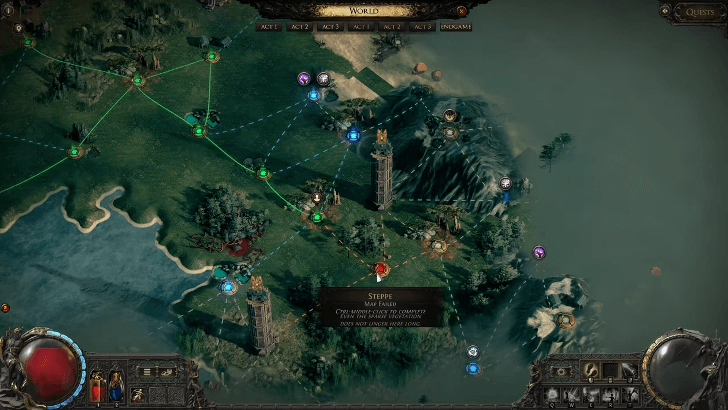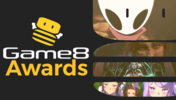Endgame Atlas of Worlds Guide
NEW: 0.4.0c Patch | Stash Tab Sale
☆ Fate of the Vaal ▶︎ The Last of the Druids
┗ Bonded Mods | 0.4 Mystery Box
★ Druid: Class Overview | Builds
☆ NEW: Disciple of Varashta Ascendancy!
★ Best Class | Best Builds | Leveling Builds

The Atlas of Worlds is the end-game system map used in Path of Exile 2. Check out what the Atlas of Worlds is, its mechanics, and all the end-game systems associated with it in this guide.
List of Contents
How to Unlock the Atlas of Worlds
Complete the Campaign

Once you've finished all three acts in Cruel difficulty, you'll be able to unlock the Atlas. You'll be transported to the Ziggurat Refuge where the Map Device, a device used to travel between maps in the Atlas, is found.
Endgame Atlas Guide
Use the Map Device to Access the Atlas

The Atlas of World features and endless amount of map nodes that you can explore. You can start exploring the atlas by interacting with the Map Device in The Ziggurat Refuge or your Hideout.
Each map node requires one Waystone to open and completing the objectives in whitin the map allows you to move pass the map node to further explore the atlas.
Explore the Atlas to Get More Atlas Passive Points

You first goal in the Atlas endgame is to cleanse the spreading corruption by finding and clearing out Corrupted Nexuses. Cleansing a Nexus of the appropriate tier rewards youwith Atlas Passive Points which you can use to further customize your mapping experience.
Unique Maps are rare map nodes that you can also complete to earn Atlas Passive Points.
Use Tablets on Towers to Empower Maps and Add More Content
You'll encounter Towers in the Atlas Map which you can insert Tablets to empower nearby map nodes or to add more content. Getting more modifiers, content, or monsters in your Maps through tablets let's you farm more loots much more quickly in expense of more difficult encounters.
Collect Boss Fragments to Fight Pinnacle Bosses
The different endgame mechanics and Citadels drop materials which you can use to fight the most difficult boss fights called Pinnacle Bosses. Not only do these bosses drop exclusive loot, but they also give Atlas Passive Points to their respective content to help you further mold you experience.
Special Locations in the Atlas of Worlds
Realmgate

Realmgates grant access to other realms depending on the items you insert via the Map Device. This is also a way to face a Pinnacle Boss of a specific map event, depending on the item you used to access the Realmgate.
Reliquary Vault
The Reliquary Vault is an area where you can use Reliquary Keys to open a special area and obtain a random Foil Unique!
Citadels
Citadels are special locations in the atlas maps that contain powerful bosses that drop boss fragments for The Arbiter of Ash Pinnacle Boss fight. There are three different types of Citadels which each releasing a different colored beam that you can see beyond the fog in the atlas map.
The Burning Monolith

The Burning Monolith is one of, if not the most difficult, end-game system in Path of Exile 2. It involves players collecting three keys from three different enemy factions. These keys are then used to gain entry into a large fortress containing mazes and enemies that players must conquer.
The Burning Monolith Explained
Atlas Endgame Mechanics and Content
| Atlas Endgame Mechanics | ||
|---|---|---|
| - | ||
Map Boss

Map nodes with a boss feature an uber version of an Act boss. Defeating them completes the map and drops significantly more loot with higher chances of more and better-tier Waystones.
Irradiated

Irradiated maps increases the area level by one, making all monsters slightly tougher and more resilient.
Corruption

These maps contain Coalesced Corruption, which causes defeated monsters a chance to merge into stronger ones. Corruption can also randomly apply modifiers to the map.
Corrupted Nexus

Found in the center of large corrupted zones, Corrupted Nexuses contain powerful unique bosses. Defeating them grants additional Atlas Passive Skill Points at certain tiers.
Cleansed Map

After clearing a Corrupted Nexus, nearby corrupted maps become Cleansed Maps. These can roll exclusive modifiers and include a boss that may drop the Fracturing Orb crafting item.
Breach

Breaches open a tear in the reality which allows you to interact with monsters in another dimension. The monsters and the Clasped Hands in these Breaches drop Breach Splinters that can combined into a Breachstone which you can use to fight Xesht, We That Are One.
Delirium

Walking through a Delirium Mirror inside a map unleashes the rolling Delirium fog which spawn more monsters and empowers all the enemies the longer you're in the fog. You stack rewards when defeating enemies during a Delirium encounter which all drop once it ends.
Monsters in the fog will drop Simulacrum Splinters which combines into a Simulacrum (item) which you can use to enter a increasingly difficult area called the Simulacrum (area).
Expedition

The Expedition end-game system involves players helping Kalguuran settlers find Verisium artifacts by using explosives on marked dig sites. However, to get these artifacts, players must also defeat ancestral corpses reanimated by the corruption.
Logbooks dropped by Expedition monsters are large-scaled expeditions which, at higher levels, can contain the Pinnacle Boss encounter with Olroth, the Origin of Fall.
Ritual

Ritual Altars are sacrificial sites that absorbs the the monsters slain within its area and can be resummoned by interacting with the altar. The more rituals you've interacted within a map, the more monsters each successive Ritual Altar spawns. Defeating this monsters earn you Tributes which you can purchase various Favours for.
An Audience With the King is a random Favour you can purchase which allows you to access the King in the Mists Pinnacle Boss fight.
Hideout

Hideout maps are small areas that contain packs of monsters which you can clear to unlock as a Hideout. You can talk to Alva in your Hideout to change Hideouts.
Hideout Location and How to Unlock
Unique Maps

Unique Maps contain special map mechanics and rewards. These maps cannot have additional content such as Breach, and additional extra content such as Essences.
Wandering Trader

The Wandering Trader, also known as the Nameless Seer, can be found in the Moment of Zen Unique Map. This NPC allows you to take one of the many Uniques that he offers.
Deadly Map Boss

Maps tagged with Deadly Map Boss are unique maps that require certain conditions to be unlocked. In general, this involves exploring the surrounding maps and interacting with a mechanism or item.
Abyss

Abyss is the new mechanic introduced during The Third Edict update. Maps tagged with Abyss contain fissures that spawn packs of strong enemies. Once you clear all fissures within the area, various loot awaits in the form of caches or the entrance to the Abyssal Depths.
What is the Atlas of Worlds?
End-game System Map and Hub

The Atlas of Worlds, simply called Atlas, is the core of Path of Exile 2's end-game. It is an infinite map that expands in all directions and is the hub for all the end-game content and systems players can experience.
Path of Exile 2 (PoE 2) Related Guides

| Path of Exile 2 Wiki Contents | |
|---|---|
 Builds Builds |
 Classes Classes |
 Tips and Tricks Tips and Tricks |
 Bosses Bosses |
 Walkthrough Walkthrough |
 Quests Quests |
 Gems Gems |
 Items Items |
 Weapons Weapons |
 Armors Armors |
 Accessories Accessories |
 Passives Passives |
 Skills Skills
|
 Ascension Trials Ascension Trials |
 Glossary Glossary |
 Atlas of Worlds Atlas of Worlds |
 Leagues Leagues |
 Characters Characters |
 Cosmetics Cosmetics |
 Microtransactions Microtransactions |
 Spectres Spectres |
 Uniques Uniques |
 News and Updates News and Updates |
- |
List of Recommended Guides
Comment
Author
Endgame Atlas of Worlds Guide
improvement survey
01/2026
improving Game8's site?

Your answers will help us to improve our website.
Note: Please be sure not to enter any kind of personal information into your response.

We hope you continue to make use of Game8.
Rankings
- We could not find the message board you were looking for.
Gaming News
Popular Games

Genshin Impact Walkthrough & Guides Wiki

Umamusume: Pretty Derby Walkthrough & Guides Wiki

Where Winds Meet Walkthrough & Guides Wiki

Pokemon Legends: Z-A Walkthrough & Guides Wiki

Honkai: Star Rail Walkthrough & Guides Wiki

Wuthering Waves Walkthrough & Guides Wiki

Digimon Story: Time Stranger Walkthrough & Guides Wiki

Clair Obscur: Expedition 33 Walkthrough & Guides Wiki

Pokemon TCG Pocket (PTCGP) Strategies & Guides Wiki

Zenless Zone Zero Walkthrough & Guides Wiki
Recommended Games

Fire Emblem Heroes (FEH) Walkthrough & Guides Wiki

Super Smash Bros. Ultimate Walkthrough & Guides Wiki

Diablo 4: Vessel of Hatred Walkthrough & Guides Wiki

Yu-Gi-Oh! Master Duel Walkthrough & Guides Wiki

Elden Ring Shadow of the Erdtree Walkthrough & Guides Wiki

Monster Hunter World Walkthrough & Guides Wiki

Pokemon Brilliant Diamond and Shining Pearl (BDSP) Walkthrough & Guides Wiki

The Legend of Zelda: Tears of the Kingdom Walkthrough & Guides Wiki

Persona 3 Reload Walkthrough & Guides Wiki

Cyberpunk 2077: Ultimate Edition Walkthrough & Guides Wiki
All rights reserved
© 2010 - 2024 Grinding Gear Games
The copyrights of videos of games used in our content and other intellectual property rights belong to the provider of the game.
The contents we provide on this site were created personally by members of the Game8 editorial department.
We refuse the right to reuse or repost content taken without our permission such as data or images to other sites.
 How to Prepare for Dawn of the Hunt
How to Prepare for Dawn of the Hunt Best Stash Tabs to Buy
Best Stash Tabs to Buy Best Class Tier List
Best Class Tier List Which Class Should You Play?
Which Class Should You Play? Easiest Class to Play
Easiest Class to Play Twilight Order Reliquary Guide and Sharing Board
Twilight Order Reliquary Guide and Sharing Board How to Use Loot Filters
How to Use Loot Filters Diablo 4 Player's Guide to PoE 2
Diablo 4 Player's Guide to PoE 2 Best Minions to Summon
Best Minions to Summon Best Ways to Farm Currency
Best Ways to Farm Currency Best Unique Equipment
Best Unique Equipment Best Charms to Use
Best Charms to Use Best Spectres
Best Spectres Best Companions
Best Companions List of Spectres
List of Spectres All Spirit Quests and Bosses
All Spirit Quests and Bosses List of All Bonded Modifiers
List of All Bonded Modifiers


























